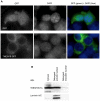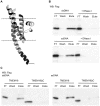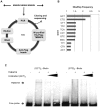Obesity risk gene TMEM18 encodes a sequence-specific DNA-binding protein
- PMID: 21980424
- PMCID: PMC3182218
- DOI: 10.1371/journal.pone.0025317
Obesity risk gene TMEM18 encodes a sequence-specific DNA-binding protein
Abstract
Transmembrane protein 18 (TMEM18) has previously been connected to cell migration and obesity. However, the molecular function of the protein has not yet been described. Here we show that TMEM18 localises to the nuclear membrane and binds to DNA in a sequence-specific manner. The protein binds DNA with its positively charged C-terminus that contains also a nuclear localisation signal. Increase in the amount of TMEM18 in cells suppresses expression from a reporter vector with the TMEM18 target sequence. TMEM18 is a small protein of 140 residues and is predicted to be mostly alpha-helical with three transmembrane parts. As a consequence the DNA binding by TMEM18 would bring the chromatin very near to nuclear membrane. We speculate that this closed perinuclear localisation of TMEM18-bound DNA might repress transcription from it.
Conflict of interest statement
Figures





Similar articles
-
Obesity-associated gene TMEM18 has a role in the central control of appetite and body weight regulation.Proc Natl Acad Sci U S A. 2017 Aug 29;114(35):9421-9426. doi: 10.1073/pnas.1707310114. Epub 2017 Aug 15. Proc Natl Acad Sci U S A. 2017. PMID: 28811369 Free PMC article.
-
Solution structure of the constant region of nuclear envelope protein LAP2 reveals two LEM-domain structures: one binds BAF and the other binds DNA.EMBO J. 2001 Aug 15;20(16):4399-407. doi: 10.1093/emboj/20.16.4399. EMBO J. 2001. PMID: 11500367 Free PMC article.
-
The carboxyl-terminal nucleoplasmic region of MAN1 exhibits a DNA binding winged helix domain.J Biol Chem. 2006 Jun 30;281(26):18208-15. doi: 10.1074/jbc.M601980200. Epub 2006 Apr 28. J Biol Chem. 2006. PMID: 16648637
-
The Obesity-Susceptibility Gene TMEM18 Promotes Adipogenesis through Activation of PPARG.Cell Rep. 2020 Oct 20;33(3):108295. doi: 10.1016/j.celrep.2020.108295. Cell Rep. 2020. PMID: 33086065
-
Homeodomain-DNA recognition.Cell. 1994 Jul 29;78(2):211-23. doi: 10.1016/0092-8674(94)90292-5. Cell. 1994. PMID: 8044836 Review. No abstract available.
Cited by
-
Unraveling the brain regulation of appetite: lessons from genetics.Nat Neurosci. 2012 Oct;15(10):1343-9. doi: 10.1038/nn.3211. Epub 2012 Sep 25. Nat Neurosci. 2012. PMID: 23007189 Review.
-
Genetic variation and reproductive timing: African American women from the Population Architecture using Genomics and Epidemiology (PAGE) Study.PLoS One. 2013;8(2):e55258. doi: 10.1371/journal.pone.0055258. Epub 2013 Feb 12. PLoS One. 2013. PMID: 23424626 Free PMC article.
-
Obesity-associated gene TMEM18 has a role in the central control of appetite and body weight regulation.Proc Natl Acad Sci U S A. 2017 Aug 29;114(35):9421-9426. doi: 10.1073/pnas.1707310114. Epub 2017 Aug 15. Proc Natl Acad Sci U S A. 2017. PMID: 28811369 Free PMC article.
-
Adipose tissue depot specific promoter methylation of TMEM18.J Mol Med (Berl). 2014 Aug;92(8):881-8. doi: 10.1007/s00109-014-1154-1. Epub 2014 Apr 26. J Mol Med (Berl). 2014. PMID: 24763707
-
Identification of protein-coding genes associated with metastatic prostate cancer.Endocr Relat Cancer. 2025 Jun 26;32(7):e250070. doi: 10.1530/ERC-25-0070. Print 2025 Jul 1. Endocr Relat Cancer. 2025. PMID: 40525903 Free PMC article.
References
-
- Jurvansuu J, Zhao Y, Leung DS, Boulaire J, Yu YH, et al. Transmembrane protein 18 enhances the tropism of neural stem cells for glioma cells. Cancer Res. 2008;68:4614–4622. - PubMed
-
- Thorleifsson G, Walters GB, Gudbjartsson DF, Steinthorsdottir V, Sulem P, et al. Genome-wide association yields new sequence variants at seven loci that associate with measures of obesity. Nat Genet. 2009;41:18–24. - PubMed
Publication types
MeSH terms
Substances
LinkOut - more resources
Full Text Sources
Other Literature Sources
Medical
Molecular Biology Databases
Research Materials

